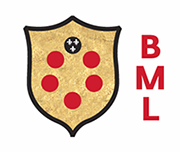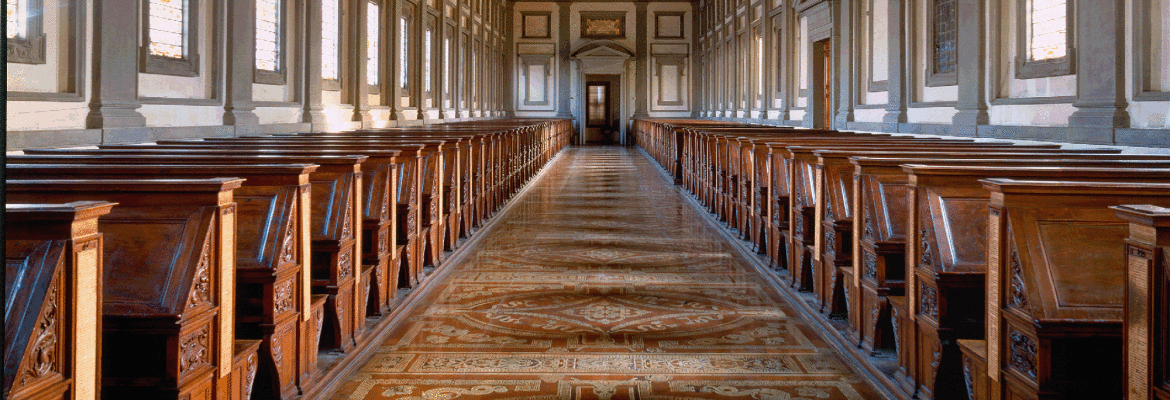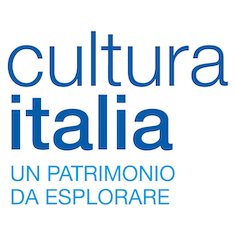Percorso pagina:
Visit shortly
THE VESTIBULE AND READING ROOM BY MICHELANGELO AND THE EXHIBITION
The Biblioteca Medicea Laurenziana, which hosts one of the most important collection of manuscripts worldwide, was projected by Michelangelo, on the commission by Giulio de’ Medici, who became pope Clement VII. He wanted to create a special location to collect all the Medici family manuscripts, around 1000 codex.
The works began in 1524 and went on until 1524, when Michelangelo moved to Rome. The whole project was resumed under Cosimo I, Duke and then Gran Duke of Tuscany and on 11 June 1571 the library was officially opened to the public.
In 1534 the library was finished but without the decorations and the furniture. The ceiling was carved in linden wood between 1549 and 1550 by Giovan Battista del Tasso and Antonio di Marco di Giano looking at the Michelangelo drawings. The floor, in red and white terracotta, finished by Santi Buglioni according to a design by Tribolo, got ideas from the ceiling, but it was enriched by some symbolic emblems linked to the Medici family. The furniture was made by 88 desks, the so call Plutei drew by Michelangelo and finished by Giovan Battista del Cinque and Ciapino. They functioned as lecterns as well as book shelves. Each desk was provided with a wooden panel on one side of each bench listed the titles of the items chained therein. The manuscripts were distributed by subject (Patristics, Astronomy, Rhetoric, Philosophy, History, Grammar, Poetry, Geography). Beginning in 1556 the windows were made by a Flemish workshop, in keeping with Giorgio Vasari’s drawings. They are masterpieces of this kind of art, and we know all these informations about the artists thanks to some archival papers. In 1559 Bartolomeo Ammannati, looking at the original wooden project by Michelangelo, finished the famous tripartite staircase in pietra serena, which is the entering point to the library.The oldest part of the Laurenziana collection, which today hosts 11.000 manuscripts, comprised classical greek and latins manuscripts and vernacular texts collected by Cosimo The Elder. The collection grew considerably thanks to the Cosimo’s sons Piero and Giovanni. Lorenzo Il Magnifico, instead, had a different idea. He wanted to create a high quality and completeness library, which was to be able to compete against the other Italian court’s library.
The exhibition “The Global Eye: Dutch, Spanish and Portuguese maps in the collections of the Grand Duke Cosimo III de’ Medici” shows, for the first time, 82 maps and landscapes which were bought by Cosimo III during his European trips. They portray the most important ports of the second part of the 17 th century. Between 1667 and 1668 Cosimo bought 65 maps which represented the American coast, the eastern and western African coast the Indian Ocean, the sud- east Asian sea, the Philippines, the Japan, The New Spain, to the other side of the Pacific Ocean. Cosimo bought this maps from Johannes Vingboons (1616-1670) who was map maker and copyst of the East India Company.Two years later Cosimo, with the help of the Portuguese mathematician Luís Serrão Pimentel (1613-1679), bought some copies of naval maps. They copied the African coast, the Persia coast, indian coast, from the Cape of Good Hope to the Malacca’s strait.
All the maps became part of the collection of the Grand Duke Pietro Leopoldo in Florence. They were framed and exposed in the Medici house in Castello. In 1921 the director of the library Guido Biagi understood their priceless value, the maps were added to the collection of the Biblioteca Medicea Laurenziana and named Carte di Castello.
The exhibition shows just a part of the collection, but it includes the most imphe oldest map of New York City (CdC 18), Mexico City (CdC 43), Malacca (CdC 46), Taiwan (CdC 7), Japan (CdC 4-5), and 4 maps which describe the Ottentotti (CdC 79-82) the ancient inhabitants of the Cape of Good Hope.






